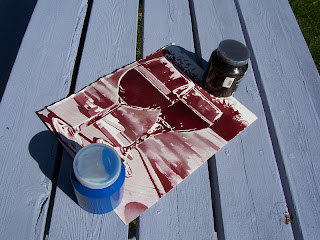Now that I’m living in a burgeoning wine region, I thought I’d push my envelope and try a medium that few artists are working in: wine. How different from working in watercolours or inks can it be?
Materials (now featuring 100% more vino).
Where to begin? With the wine, of course. With dozens of wineries in Prince Edward County to choose from, I decided on the Sandbanks Estate Winery to feature first. Their signature wine is made with a grape called Baco Noir which is rare in this area (and, unfortunately, has nothing to do with bacon or back-hoes). My medium for this painting happens to be vintage 2007.
Initial results.
At first the wine looked like a light violet mixed with some red, but as it dried, it got a little darker, towards purple. Still, the wine was very transparent and, although perfect for the initial blocking-in of shapes, wouldn’t get me the intense darkness I prefer for deep contrast. I tried laying down a second “coat” on the wine parts after the initial pass has dried, but I could tell simply adding wine on top of wine wouldn’t cut it in the long run. I’d heard of other artists cooking the wine, reducing it as though making a sauce, to get it to a dark and a little thicker, too.
Small Pond Test Kitchen.
I didn’t measure the wine before cooking, but I poured a good number of glugs into the small pot and began reducing it on medium, testing the wine with a brush on scrap paper intermittently. After just over half an hour, I decided to stop the reduction for fear of reducing it all away. The wine was now darker, redder, and slightly thicker –not perfect, but better.
Reduced.
During the reduction, I added some water to the wine in my cup to lighten it and filled in the remaining white areas in the background and cutting board.
Pretty good for grapes.
The reduced wine looked pretty good –rich and deep red– but I discovered that wine takes longer to dry than regular watercolour paint. In fact, after laying down the latest “coat” of wine at around 11pm that first night, the painting was still wet the next morning at 8:30am, so I put it in the sun to dry. Exposure to sunlight might wreak havoc with the lightfastness (i.e. permanence) of the pigments, but I couldn’t think of another way to dry it (besides sitting over it with a hair dryer, wasting time and electricity).
The never-drying painting.
It's been a year now since this experiment (yes, the final painting below is dry) and my six new wine paintings are nearly done. I used three different wines, including the bottle of baco used in this experiment. Interestingly –but not unexpectedly– the wine has turned a rusty brown colour, both the liquid in the bottle and the wine in the painting, so the deep purple colour below has now oxidized and changed.
Baco Noir







Comments